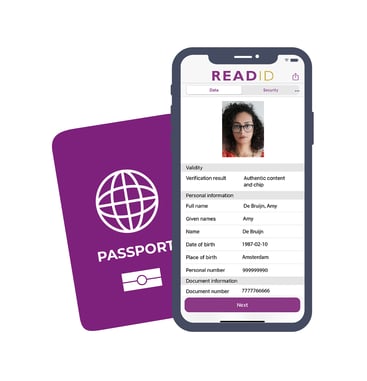As of April 2024, 172 countries issue International Civil Aviation Organisation (ICAO) Doc 9303 compliant chipped identity documents.
Many countries announce when they plan to release a new iteration of a chipped identity document, or their first ever chipped identity documents, but not all do so. However, Inverid has a game-changing asset that enables us to know when a new chipped identity document is about to enter circulation… our in-house data analysis tooling, ReadID Analytics.
ReadID Analytics collects anonymous meta data (such as document type, operating system version, and never personal information) from chipped identity documents used with our free app ReadID Me or customer deployments for analysis to improve Inverid’s products. ReadID Analytics can also be used by our customers to analyse and optimise their transactions.
Access to this data has allowed Inverid to detect instances of new ICAO compliant identity documents being tested before they were announced publicly.
But how often are existing identity documents updated with a new NFC version? How frequently do countries introduce their first ever electronic identity documents? How are new electronic identity documents tested before release? We will explore these questions in a comprehensive timeline using a mix of ReadID Analytics and publicly available data in this blog post.
How often are new electronic identity documents released?
Using data in ReadID Analytics and backed up by publicly available data, we have constructed an estimated timeline of chipped identity document releases and behind-the-scenes changes, detected with ReadID Analytics meta data, and backed up with either publicly available information or identity document databases that Inverid has access to.
For example, in April of 2021, we saw a large spike of traffic from a Mexican ePassport, followed by another large peak at the beginning of October in the same year. Around this time, the Mexican government announced the issue of their first ever electronic passports, allowing us to hypothesise that the initial April peak was testing of the new document using the ReadID Me app.

Another example of this detection took place in early October of 2022, when we noticed instances of an ePassport from Belize in ReadID Analytics data. This was the first ePassport Belize would have ever issued, and soon after we detected this traffic, Belize released information regarding their upcoming Electronic Passport Issuance and Control system, confirming our traffic as a new electronic identity document.
New versions of existing documents, or brand new chipped identity documents, detected using ReadID Analytics:

Not all of the instances mentioned in this timeline have publicly available sources such as press releases, but all have been verified via confidential identity document databases that Inverid has access to. The number of countries issuing chipped identity documents grows steadily, year by year.
Do electronic identity documents get new versions?
Once a country starts to issue electronic identity documents, new versions are released over time, much like smartphones- albeit electronic identity documents aren't updated on a yearly basis.
Inverid can estimate these kinds of cases when we see a change in the data, or data structure, inside an electronic identity document's chip, alongside other factors. An example of this is the Polish passport mentioned in the timeline above. Poland first started issuing biometric (chipped) passports in 2006, but we detected a never before seen version of the Polish passport in ReadID Analytics in January of 2020, leading us to estimate that this was a new version of the document being tested or entering public circulation.
How are new electronic identity documents tested?
It can also happen that we see experimental use of new chipped identity documents. For example, we may have seen testing in ReadID Analytics of a new passport from a country that has never previously issued electronic identity documents, but there was no official announcement made by the issuing authority of appearances of the document in news outlets. Therefore, we can assume that this sudden spike in traffic for a particular document may be a government/issuing body testing the NFC functionality of their identity document.
Inverid does carry out additional checks to ensure that these assumptions are based on as much evidence as possible. For example, when our team thinks we have detected a new document but cannot find an official source that sites it’s release, we will investigate the validity of the document signing certificate against our sources, if the document is authentic and passes security checks inherent in NFC reading, and the volume of readings detected.
What do we use this information for?
When verifying identity documents, it is important to select the optimal flow to create high conversion based on many factors of said identity documents. This means constant vigilance regarding changes to chipped identity documents is necessary to optimise solutions for our customers, innovate at the fastest pace, and provide the highest amount of identity document coverage.
From our tooling ReadID Analytics, we know what documents support what protocols in what release versions. This information is used to use the best protocol in any context when verifying an identity document.
This reduces the number of verification attempts as well as can increasing reading speed, creating an opportunity for optimal conversion no matter the type of device or release version of an identity document being used. As a consequence, your business has customers that convert on their first attempt with an enjoyable user experience, creating trust in your brand and services thanks to ReadID.
You can learn more about which ID cards and ePassports ReadID can read and verify in our blogs. For a full summary of public information on ReadID’s document coverage, download our identity documents summary.










